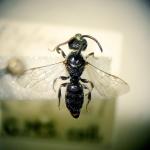Halictus exetinus COCKERELL 1938; Halictus indecisus COCKERELL 1938
Coastal localities in east Devon, Dorset and the Isle of Wight. The type locality of the species is Sidmouth, Devon (Perkins 1895). Records are best based on males, as females are generally very difficult to distinguish from those of L. punctatissimum. Rare and sporadic in the south-west Palaearctic, where the species is distributed from Britain to Romania, and from Morocco to Turkey. Warncke (1981) has prepared a distribution map for the species.
Listed as RDB3 Rare in Shirt (1987) and by Falk (1991).
Mainly rough coastal landslips.
Females from late May to at least August; males from the end of July to late September.
Females usually nest gregariously in burrows excavated in clay exposures at the base of cliffs and slopes above the beach (Spooner 1929).
Males visit wild carrot blossom and yellow-flowered Asteraceae. Female Lasioglossum, provisionally identified as L. angusticeps, have been observed on several occasions visiting common bird’s-foot-trefoil (Lotus corniculatus) flowers (pers. abs.).
Stylopised males have been collected in two Dorset sites (personal records), probably affected by a Halictoxenos species, perhaps the same as that affecting L. punctatissimum.
2002


